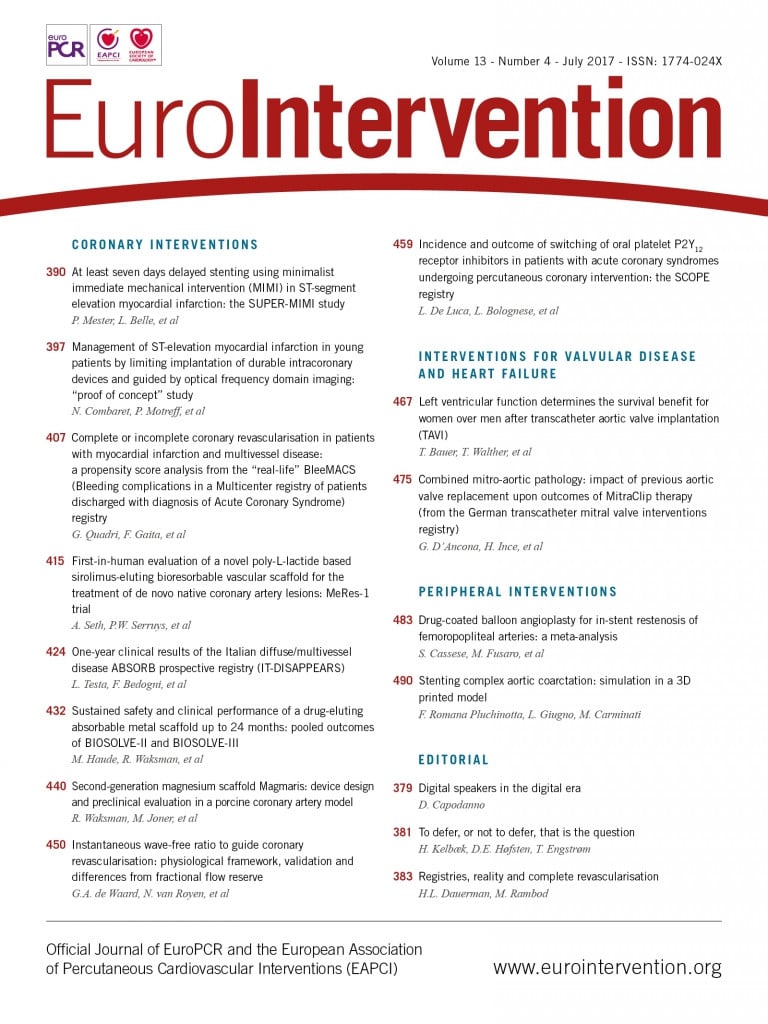
I started writing this editorial on the way back from South Korea, at the end of two consecutive congressional days in Seoul for the 22nd TCTAP conference, and then I put it on hold for a while. TCTAP took place this year from 25 to 28 April, the preceding week being characterised by worrying news on the growing political tension between North Korea and the USA. Some readers may remember that on 25 April, coinciding with the anniversary of the creation of the Korean People’s Army, international observers anticipated a likely North Korean missile test to act as a detonator for a conflict of vast proportions. A somewhat simplistic vision of the story, but probably not so far from reality, allowed envisaging war scenarios that involved nearby countries, including –of course– South Korea. When this text was completed this was fortunately not the case and we hope this scenario never happens.
As is understandable and without entering into the merits of personal decisions, the fear of the sudden outbreak of a war caused the last-minute cancellation of some TCTAP participants. Among them were some well-known international speakers who had been announced in key sessions of the meeting. This kind of defection would bring other conferences to their knees but certainly not a well-organised meeting like TCTAP, most notably in such a technologically advanced country as South Korea. So here is the surprise that you do not expect in the middle of a plenary session in the main arena: the keynote lecture of the international guest ... via the Web. Korean masters of complex percutaneous coronary intervention certainly know how to handle bail-out solutions when things get challenging.
Anyone who has ever experienced the presentation of a clinical case at a local or international congress knows that there is a circumstance that can undo the success of any performance. What I am referring to is the so-called and notorious “technical problem”, i.e., malfunction of the microphone, background noise or a movie loop that does not start. Well, when you venture into a Web presentation in front of hundreds of people, everything has to work perfectly. Any technical problem would be amplified by the absence of the speaker on the stage, and the attention of the audience would be immediately and irretrievably lost. None of these problems happened that day in the TCTAP main arena, with perfect lag-free connection, high-resolution images, strong and clear sound, and picture-in-picture image of the speaker broadcasting from thousands of miles away. The most distracted ones may not even have noticed the physical absence of a person on the podium, considering how well handled that moment was from a technical point of view.
A few hours later, another virtual speaker gave his remote presentation in another room. This time the connection was from the hospital, and it was even more credible, since we are now quite used to live case transmissions from worldwide cathlabs to the conference venue. Here I noticed another detail that I had missed earlier in the main arena: the absence of the speaker did not affect the attendance of the audience at all. The room was packed and many people had not found a seat but were standing patiently to enjoy the talk. Finally, in a third morning session, I noticed a few crunches of what so far seemed to me to be the perfect surrogate for a traditional conference presentation: slow connection, somewhat grainy image, occasionally some noise that made me lose something of what the speaker intended to say. Sufficient enough, all in all, except that the absence of the speaker before the beginning of the webcast caused him to miss the first presentations and subsequent discussions. Thus, his talk largely resulted in a compendium of things that had already been said.
Certainly this was not the prime time for a live webcast during a conference meeting, but it was the first time that I had witnessed it to that extent and that was enough to stimulate some critical thinking. After testing the experience three times within the same meeting, if I had to put the case for the virtual speaker in a kind of SWOT analysis1, I would express myself in these terms. The “strength” lies in the ability to resist sudden defections with a very effective solution. If the connection is good, after a few seconds you honestly forget about the physical absence of the speaker. The “weakness” lies in the fact that the technical problem is always lurking. In addition, discussion with the panel and the audience becomes problematic if not impossible. The “opportunity” I see is to take advantage of the contributions of selected world-renowned experts by relieving them of the burden of travel and reducing the costs for organisers. Not a trivial matter these days. The “threat” is that episodes such as these become the rule, undermining the very essence and value of international meetings: exchange, network, questions, and discussion. This seems to me to be a formidable problem.
The digital presence of speakers at international congresses could in fact be even more refined than the examples I just gave. Some time ago, one of the candidates in the French presidential election intervened simultaneously on the stage of two events related to his electoral campaign in cities that were 450 km apart. How? Using a hologram, as in a Star Wars Jedi Council. Similar cases had already occurred in the past during election polling in Turkey and India. We already see more and more educational resources shared online in the form of streaming, webcasts, webinars, commented slides, and other kinds of media. A number of sessions during the last TCT were recorded on site –with no audience– for future website transmissions. Is this the future of international congresses in the era of new rules on direct sponsorship2? Speakers speaking from remote stations, attending participants in front of an empty podium in ever-surreal halls, or connecting from home, making the very existence of the physical meeting a negligible fact, if not even unnecessary?
P.S. I am concluding the writing of this editorial on the way back from Paris where the traditional EuroPCR has just ended. The tensions between the USA and North Korea seem at rest, thankfully. With its nearly 12,000 participants, the usual high degree of networking and interaction, and all of the speakers in the right place, EuroPCR came just at the right time to wake me up from the dystopian dream of virtual congresses for digital speakers and digital participants.

